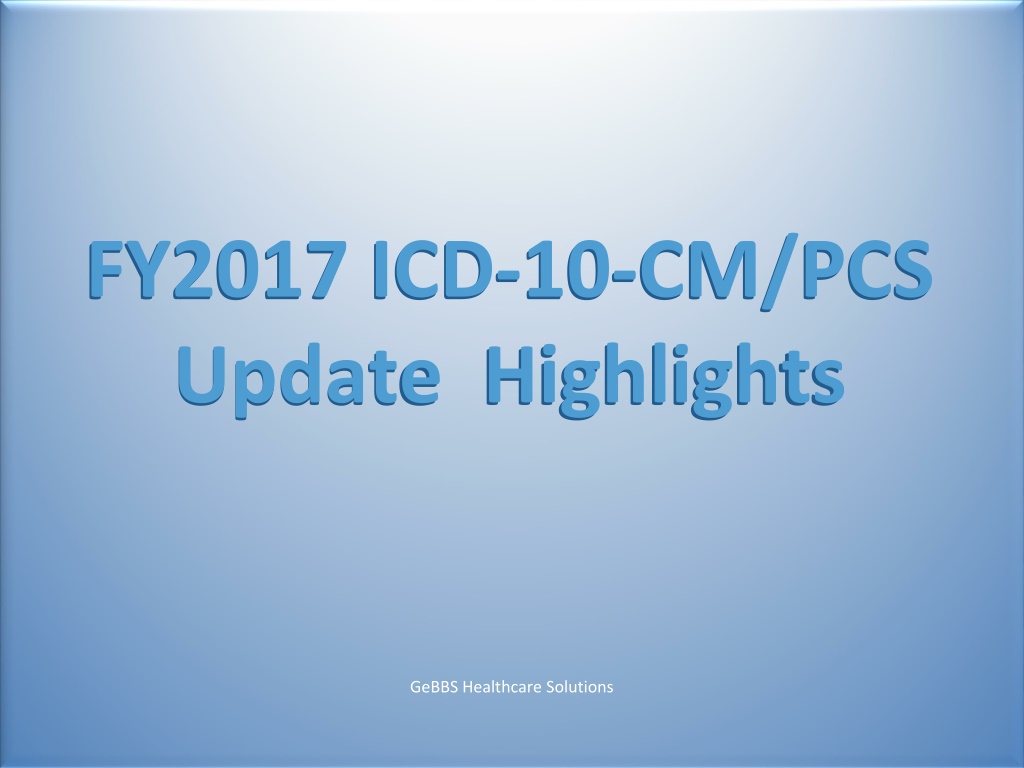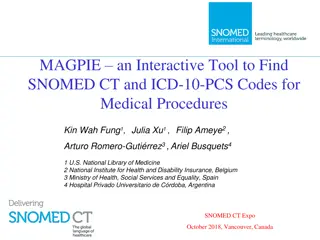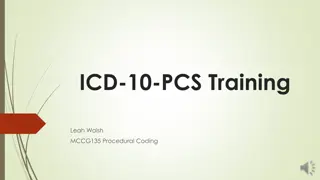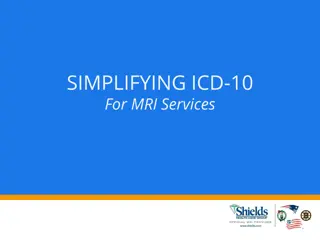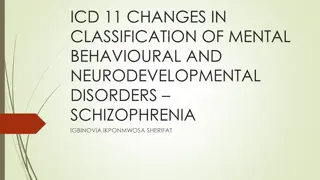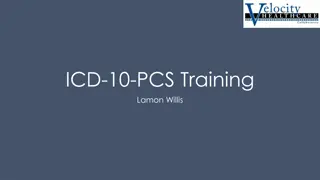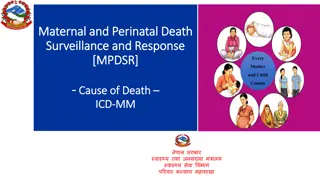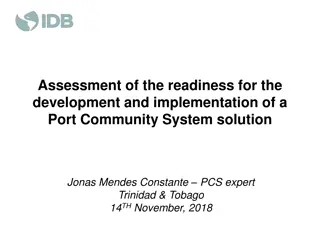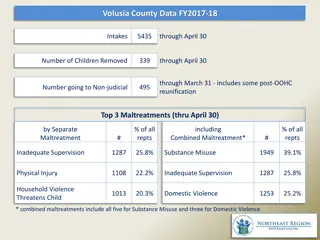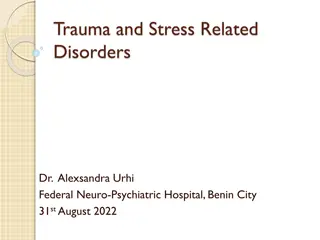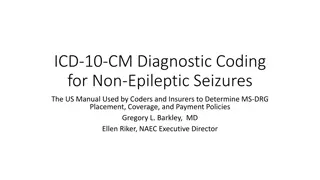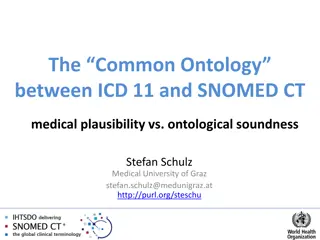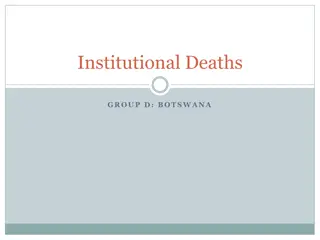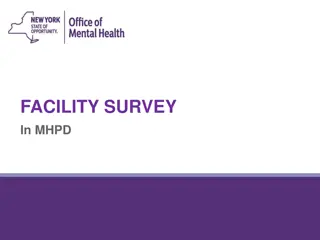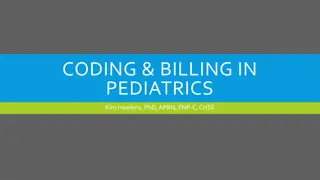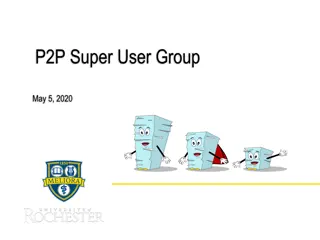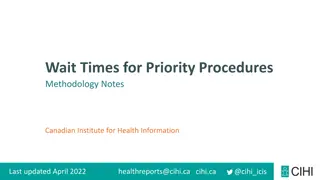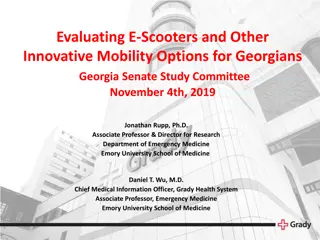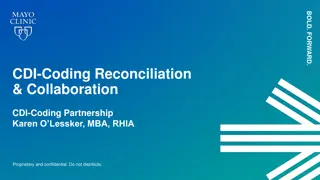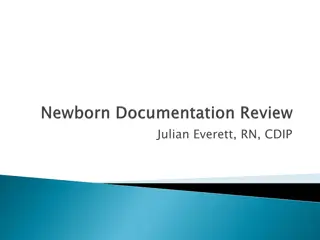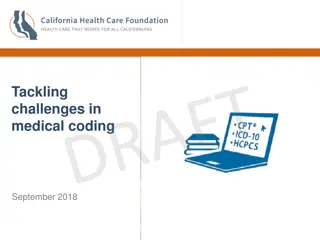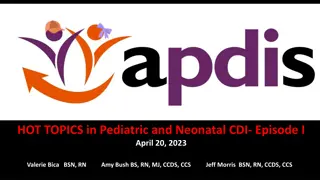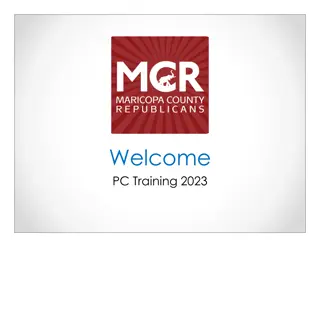Updates and Highlights in FY2017 ICD-10-CM/PCS
In the FY2017 update of ICD-10-CM/PCS, significant changes have been made with new codes, updates, and deletions affecting coding diagnoses. The update includes coding highlights related to various conditions like bacteriuria, sepsis, pre-diabetes, and Zika virus. The Third International Consensus Definitions for Sepsis and Septic Shock introduce new definitions and criteria for identifying sepsis and septic shock. Detailed information on the Sepsis-3 definitions, diagnostic criteria, and clinical implications are provided in the update.
Download Presentation

Please find below an Image/Link to download the presentation.
The content on the website is provided AS IS for your information and personal use only. It may not be sold, licensed, or shared on other websites without obtaining consent from the author. Download presentation by click this link. If you encounter any issues during the download, it is possible that the publisher has removed the file from their server.
E N D
Presentation Transcript
FY2017 ICD-10-CM/PCS FY2017 ICD-10-CM/PCS Update Highlights Update Highlights GeBBS Healthcare Solutions
Coding Highlights Now we find ourselves in the center of FY 2017 Update Overload with 3,827 PCS and 1,943 CM updates CM has received 1943 new codes while 422 have been updated and 305 have been deleted. The following are just some of the updates on the CM codes which will affect coding diagnoses that were coded less specifically prior to this update Slide 2
Coding Highlights Bacteriuria N39.0 now coded as R82.71 o Sepsis has new clinical criteria Pre-diabetes/prediabetic R73.09 now codes to R73.03 Zika virus has been assigned A92.5 Section C.13.c Subsequent encounter 7th characters are to be assigned for routine care of fractures during the healing and recovery phase as well as treatment of problems associated with the healing, such as malunions, nonunions, and sequelae. Slide 3
The Third International Consensus Definitions for Sepsis and Septic Shock (Sepsis-3) The SIRS Criteria, Sepsis, Severe Sepsis, Septic Shock, and Multiple Organ Dysfunction Syndrome definitions of sepsis are being replaced as they were found to possess too many limitations; the current use of 2 or more SIRS criteria to identify sepsis was unanimously considered by the task force to be unhelpful. The SOFA Score is a well-known and often-used score in critical care to assess poor outcome in ICU patients. The qSOFA Score was introduced by the Sepsis-3 group in February 2016 as a simplified version of the SOFA Score as an initial way to identify patients at high risk for poor outcome with an infection. The qSOFA simplifies the SOFA score drastically by only including its 3 clinical criteria and by including "any altered mentation" instead of requiring a GCS 13. Slide 4
The Third International Consensus Definitions for Sepsis and Septic Shock (Sepsis-3) Sepsis is defined as life-threatening organ dysfunction caused by a dysregulated host response to infection. Septic shock is a subset of sepsis in which underlying circulatory and cellular/metabolic abnormalities are profound enough to substantially increase mortality. In 2016 septic shock, despite adequate fluid resuscitation, requires Vasopressors to maintain MAP of 65mmHG and lactate >2 mmol/l.
Sepsis Diagnostic Criteria General Variables Fever(T>38.3C, hypothermia (core temp <36C. HR/ > 90 beats/min or > 2 SD above normal value for age Tachypnea RR > 20/min. Altered Mental Status Significant edema or positive fluid balance>20mL/kg over 24 hours. Hyperglycemia(plasma glucose) >140mg/dl or 7.7 mmol/L in the absence of diabetes Inflammatory Variables Leukocytosis (WBC >12,000 uL). Leukopenia (WBC <4,000 uL ). Normal WBC count with >10% immature forms. Plasma C-reactive protein > 2 SD above normal value. Plasma procalcitonin > 2 SD above normal value Hemodynamic Variables Arterial hypotension (SBP <90mmHg, MAP<70mmHg, or an SBP decrease>40 mmHg in adults or < 2 SD below normal for age
Sepsis Diagnostic Criteria continued Organ Dysfunction Variables Arterial hypoxemia (Pa02/Fi02<300). Acute oliguria (urine output <0.5mL/kg/hr for at least 2 hours despite adequate fluid resuscitation. Creatinine increase >0.5 mg/dL or 44.2 umol/L Coagulation abnormalities (INR.1.5 or aPTT>60 s). Ileus (absent bowel sounds) Organ Dysfunction Variables continued: Thrombocytopenia (platelet count <100,000 uL) Hyperbilirubinemia (plasma total Tissue Perfusion Variables Hyperlactacemia (lactic acid>1 mmol/L) Decreased capillary refill or mottling bilirubin >4 mg/dL or 70 umol/L)
Sepsis Diagnostic Criteria continued Severe Sepsis: Is sepsis-induced tissue hypoperfusion or organ dysfunction (any of the following thought to be due to infection) Sepsis-induced hypotension Lactate above upper limits laboratory normal Urine output <0.5 mL/kg/hr for > 2 hours despite fluid resuscitation Acute lung injury with Pa02/Fi02 <250 in the absence of pneumonia as infection source Acute lung injury with Pa02/Fi02 <200 in the presence of pneumonia as infection source Creatinine >2.0 mg/dL ( 176.8 umol/L) Bilirubin >2 mg/dL (34.2 umol) Platelet count , 100,000 uL Coagulopathy (INR >1.5)
Sepsis Diagnostic Criteria Severe Sepsis continued: Laboratory Tests: CBC CMP Lactic Acid level Procalcitonin Level Blood cultures, Culture of other possible sources or sites like urine, sputum, wound that may have relation to existing infection Diagnostic Tests: CXR CT scan if applicable, other imaging tests of suspected body system as possible source of infection Treatment: broad spectrum IV antibiotics, IV fluids (crystalloids), Vasopressors, 02 supplement/mechanical ventilation if with respiratory failure or ARDS, sedatives, nutrition supplement, surgery
Coding Highlights National Institutes of Health Stroke Scale (NIHSS) has been added with scores from 1 42 (R29.7-). The type of cerebral infarction is coded first from category I63 Resulting in 43 new codes. Starting at R29.700 (indicating an NIHSS score of 0) all the way up to R29.742 (indicating an NIHSS score of 42) o Stroke clinical criteria There are now codes to reflect cognitive deficits from certain cerebrovascular disease in the I69 code set. Until this update we were only able to code those related to motor and speech skills Slide 10
Coding Highlights The Glasgow coma scale now requires a 7thcharacter. When was the patient assessed? We will now be able to reflect when the assessment was completed. 21 codes have been deleted from the Concussion subcategory. They were proven to not accurately reflect the diagnosis of concussion. Hypertension and heart disease with the new with guideline CHF is included under hypertension. This will be coded as a combined code. Unless the provider documents they are from a different cause This also applies to DM with unless the provider documents they are from a different cause. ** Offical Guidleine for coding and reporting FY 2017 Page 43 of 114 Slide 11
CVA Clarification Guideline The medical record reflects the following clinical indicators, risk factors, and treatment: Clinical Indicators: MRI of brain shows acute cerebral ischemia, acute infarct right middle cerebral artery, moderate cytotoxic edema, unresponsive, ROS shows left sided hemiparesis. Risk Factors: AFIB, noncompliance with anticoagulation Treatment: heparin drip, IV Mannitol Please clarify and document your clinical opinion if you are treating the following: Right middle cerebral artery acute embolic CVA Other: ______________________________ Unable to further specify Other explanation of clinical findings (please specify)__________________ Unable to determine ( no explanation for clinical findings) Please clarify and document your clinical opinion in the progress notes and discharge summary, including the definitive and/or presumptive diagnosis (suspected or probable) related to the above clinical findings. Please include clinical findings supporting your diagnosis.
Hypertensive Urgency Chapter 9 In coding for Hypertensive Urgency keep in mind the following in hypertensive Crisis BP rises quickly and could potentially damage organs could be urgent or emergent. Hypertensive Urgency is defined as a sudden severe rise in blood pressure requiring early evaluation of both blood pressure and organ function. BP is 180 or higher for the Systolic and 110 or higher for diastolic. Hypertensive emergency is more critical with similar BP but is accompanied by symptoms of organ damage. Previously we were unable to code this to specificity, we now have codes to reflect the specified type. Slide 13
Hypertensive Urgency I16.0, Hypertensive urgency I16.1, Hypertensive emergency I16.9, Hypertensive crisis, unspecified. If the provider s documentation doesn t specify urgency or emergency, you ll report the unspecified code. Slide 14
HTN Specificity Query Dear Doctor The HP states BP is 180 Systolic over 110 diastolic. Creatinine is high and first Progress Notes states patient has Acute Renal Failure. Based on these clinical indications, please indicate if you were treating one of the following diagnoses: Hypertensive, unspecified Hypertensive urgency Hypertensive emergency Unable to determine Other (please specify)____________________ Slide 15
PCS Highlights The PCS changes for FY 2017 has resulted in 12 deleted codes, 491 revised titles and 3,827 new codes. The following is a brief highlight allowing us to look at some areas of change. Most additions/changes were made to the Cardiovascular specialty for FY 2017 Slide 16
PCS Highlights Indocyanine green dye has been added as a 7thcharacter qualifier in the measurement and monitoring section Root Operation Creation is no longer just for gender reassignment but also to include creation of a body part to the extent possible that replicates the anatomic structure or function absent from the body such as creation of a left atrioventricular valve from the common atrioventricular valve. Slide 17
PCS definition change Control no longer just reflects post procedural bleeding. We can now utilize this pcs code when there is other acute bleeding being addressed. Control definition is now listed: Stopping, or attempting to stop, postprocedural or other acute bleeding Slide 18
PCS New Root Operation Perfusion Definition: Extracorporeal treatment by diffusion of therapeutic fluid This was added to the Extracorporeal Therapies section this was an addition of 4 new PCS codes. Slide 19
PCS Updates Ascending aorta Descending aorta Aortic arch Slide 20
Aorta sites Clinical Criteria Dear Doctor Your operative note states thoracic aortic aneurysm repair . The CT states enlargement of the aneurysm of ascending aorta. Based on the clinical indications, please indicate if the thoracic aneurysm can be further specified as: Aortic Arch Aneurysm Ascending Aortic Aneurysm Descending Aortic Aneurysm Unable to determine Other (please specify)____________________ Slide 21
New Artery Bypass codes Pulmonary artery codes have been added when coding bypass you will see: Left Pulmonary Artery: 021R Right Pulmonary Artery: 021Q Pulmonary Trunk: 021P Slide 22
Artery Bypass Coding continued Coding for pulmonary vein bypass: 021V0KS Bypass Superior Vena Cava to Right Pulmonary Vein with Nonautologous Tissue Substitute, Open Approach 021V0KT Bypass Superior Vena Cava to Left Pulmonary Vein with Nonautologous Tissue Substitute, Open Approach 021V0KU Bypass Superior Vena Cava to Pulmonary Vein Confluence with Nonautologous Tissue Substitute, Open Approach The description for coronary artery bypasses has been revised to read arteries instead of sites . Previous code: Four or More Sites: 0213 Revised code: Four or More Arteries: 0213 Slide 23
Perfusion Codes Added For Donor Organs These codes are for fluid being pumped through donor organs to preserve them some of those codes are: 6AB50BZ Perfusion of Circulatory Donor Organ, Single 6ABB0BZ Perfusion of Respiratory System Donor Organ, Single 6ABF0BZ Perfusion of Hepatobiliary System and Pancreas Donor Organ, Single 6ABT0BZ Perfusion of Urinary System Donor Organ, Single Slide 24
New Technology Codes As we advance in our technology we find that new technology makes its way into our operating rooms leaving us with no way to code that procedure. We now have codes to reflect new technology/devices being used. Some of these codes are: Spinal XRG1092 Fusion of Cervical Vertebral Joint using Nanotextured Surface Interbody Fusion Device, Open Approach, New Technology, Group 2 Slide 25
New Technology Growth Rods XNS3032 Reposition of Cervical Vertebra using Magnetically Controlled Growth Rod(s), Open Approach, New Technology Group 2 XNS3432 Reposition of Cervical Vertebra using Magnetically Controlled Growth Rod(s), Percutaneous Endoscopic Approach, New Technology Group 2 Uridine Triacitate XW0DX82 Introduction of Uridine Triacetate into Mouth and Pharynx, External Approach, New Technology Group 2 Liver Subsititue Porcine XHRPXL2 Replacement of Skin using Porcine Liver Derived Skin Substitute, External Approach, New Technology Group 2 Slide 26
There have been so many updates that it is truly hard to focus on just one area. Remember with the changes at hand and in everyday practice it is a good idea to use the Index and Tabular when coding. To get a full listing of the changes, please contact us at Sales@gebbs.com or 888.539.4282 Slide 27
Disclaimer The slides in this presentation were used to accompany a talk given during the 2016 AHIMA Convention. Neither the information contained on these slides, nor the accompanying talk and/or recording thereof construe legal advice. No attorney/client relationship is formed through the viewing of these slides nor listening to any audio recording of the talk. The materials contained within this Power Point do not constitute medical advice which should be sought from qualified medical advisor.
References AHIMA Practice Brief: How to Write a Compliant Query http://journal.ahima.org/2016/07/13/get-ready-code-downpour- on-its-way/ CMS https://www.cms.gov/Medicare/Coding/ICD10/2017-ICD-10-PCS- and-GEMs.html CDC Centers for Disease Control, Infectious Disease Society of America, ICD-10 CM Coding Manual 2016. Critical Care Medicine
Thank You! Thank You! Jessica Taylor 201.227.0088 x259 Jessica.taylor@gebbs.com Julie Hager 888.539.4282 x262 Julie.hager@gebbs.com Slide 30
